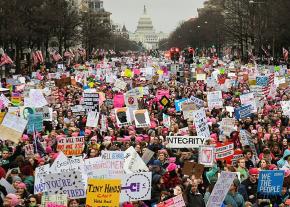Putting protests in perspective
reviews a book on the history of protest, organization and resistance through to the Trump era in his column for Inside Higher Ed. The article was published on the eve of this year’s Women’s Marches last month. The Women’s March in Washington drew an estimated 100,000 people, surpassing expectations while remaining smaller than the previous two record-setting events.
DISPLACED FROM the National Mall by a partial government shutdown and facing the likelihood of harsh weather, the third Women’s March on Washington, D.C., may well draw an even smaller turnout than the presidential inauguration did two years ago. On the other hand, the first march, that same weekend, remains a difficult act to follow.
L.A. Kauffman’s recent book How to Read a Protest: The Art of Organizing and Resistance (University of California Press) contains a table called “Marching Everywhere: The Largest Coordinated Protests in U.S. History,” with data on eight of them from the past 50 years. The National Women’s March of January 2017 sets the record, with at least 4.2 million participants in more than 650 cities. That is more than twice the number of participants, in more than three times as many cities, as the Moratorium to End the War in Vietnam in October 1969. Kauffman, a longtime activist in and historian of protest movements, acknowledges the difficulty of making such estimates, given the propensity of official sources to minimize and organizers to exaggerate. But the figures she gives for the first Women’s March line up fairly closely with the calculations of two social scientists presented in The Washington Post in 2017. For the second Women’s March, held in January 2018, Kauffman reports a turnout of “at least 2.2 million participants” in over 400 cities.

By comparison, credible estimates for the largest of the Tea Party demonstrations — held on Tax Day in April 2009 — range from 268,000 participants in more than 200 cities to 311,000 in not quite 350 cities. These figures may suggest that feminist fury is 10 times stronger than the so-called populist variety, though numerous methodological caveats would apply.
“READING” A massive nationwide protest, to use Kauffman’s term, means understanding how it has absorbed and made use of the examples of previous mobilizations. The digesting of experience is, of course, conscious and deliberate on the part of organizers like the author herself, but a great deal of it has also been absorbed, through osmosis, by the larger public. Kauffman identifies the 1963 March on Washington as something like the matrix in which a new kind of civic participation took shape:
“Mobilization” is first and foremost a military term — the readying and amassing of troops for war — and before that August Wednesday, no civilian force in the United States had ever tried to move people on this scale for political purposes. There had been very large parades of various kinds...but the huge crowds who attended these events came as spectators, not as marchers. To a substantial degree, organizing the March on Washington was a matter of improvisation and guesswork, as there were no prior models to follow for organizing a protest this large.
The organizers kept the event unified and on message through printed signs calling for school integration, full citizenship, a higher minimum wage and a few other agreed-upon demands. No unauthorized placards were allowed. “The protest march that’s come to epitomize peaceful popular dissent in America,” Kauffman writes, “was an event where all but authorized messages were silent.” In addition, a “thoroughgoing coordination between protest planners and the White House on nearly every aspect” of the event went “well beyond the kind of logistical support that would become standard administrative practice for protests in the future.”
Nor did the uniformity of messaging at the 1963 march continue at large protests, as much as organizers might sometimes wish it had. A mixture of printed and handmade placards has become the norm — and a difficult one to read at times. “With each decade that has passed since the original March on Washington,” notes Kauffman, “there are fewer and fewer large organizations with a close and strong enough relationship to their base that they can directly mobilize their members.” When large mobilizations do occur, it is often through coalitions of organizations that can hammer out a few common slogans but know better than to expect demonstrators to remain within their ambit.
Besides, very few organizing committees are nearly as imaginative as a comparable body of random individuals with a flair for making posters. Which brings us back to the first Women’s March, two years ago, which placed much strain on art-supplies retailers, who kept selling out of foam-core boards and paint markers. “In just the week before people marched around the country,” Kauffman writes, “some two million poster boards were sold nationwide.”
How to Read a Protest also suggests that the mobilization in 2017 was so fast and ad hoc that arranging to get a sufficient number of posters printed was a nonstarter. Perhaps, but there was plenty of time to organize for the first anniversary protests last year, and handmade signs were abundant then, too. And they surely will be on Saturday. For many people, it seems, having the White House occupied by someone with a history of candid misogyny and boasts about sexual assault requires an individualized response. I’d like to think someone will be out collecting the best signs on behalf of the Smithsonian, despite being on furlough.
First published at Inside Higher Ed


